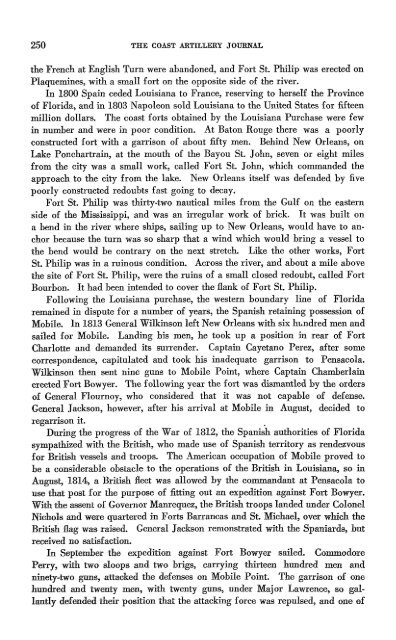THE COAST ARTILLERY JOURNAL - Air Defense Artillery
THE COAST ARTILLERY JOURNAL - Air Defense Artillery
THE COAST ARTILLERY JOURNAL - Air Defense Artillery
You also want an ePaper? Increase the reach of your titles
YUMPU automatically turns print PDFs into web optimized ePapers that Google loves.
250 <strong>THE</strong> <strong>COAST</strong> <strong>ARTILLERY</strong> <strong>JOURNAL</strong><br />
the French at English Turn were abandoned, and Fort St. Philip was erected on<br />
Plaquemines, with a small fort on the opposite side of the river.<br />
In 1800 Spain ceded Louisiana to France, reserving to herself the Province<br />
of Florida, and in 1803 Napoleon sold Louisiana to the United States for fifteen<br />
million dollars. The coast forts obtained by the Louisiana Purchase were few<br />
in number and were in poor condition. At Baton Rouge there was a poorly<br />
constructed fort with a garrison of about fifty men. Behind New Orleans, on<br />
Lake Ponchartrain, at the mouth of the Bayou St. John, seven or eight miles<br />
from the city was a small work, called Fort St. John, which commanded the<br />
approach to the city from the lake. New Orleans itself was defended by five<br />
poorly constructed redoubts fast going to decay.<br />
Fort St. Philip was thirty-two nautical miles from the Gulf on the eastern<br />
side of the Mississippi, and was an irregular work of brick. It was built on<br />
a bend in the river where ships, sailing up to New Orleans, would have to anchor<br />
because the turn was so sharp that a wind which would bring a vessel to<br />
the bend would be contrary on the next stretch. Like the other works, Fort<br />
St. Philip was in a ruinous condition. Across the river, and about a mile above<br />
the site of Fort St. Philip, were the ruins of a small closed redoubt, called Fort<br />
Bourbon. It had been intended to cover the flank of Fort St. Philip.<br />
Following the Louisiana purchase, the western boundary line of Florida<br />
remained in dispute for a number of years, the Spanish retaining possession of<br />
Mobile. In 1813 General Wilkinson left New Orleans with six hhndred men and<br />
sailed for Mobile. Landing his men, he took up a position in rear of Fort<br />
Charlotte and demanded its surrender. Captain Cayetano Perez, after some<br />
correspondence, capitulated and took his inadequate garrison to Pensacola.<br />
Wilkinson then sent nine guns to Mobile Point, where Captain Chamberlain<br />
erected Fort Bowyer. The following year the fort was dismantled by the orders<br />
of General Flournoy, who considered that it was not capable of defense.<br />
General Jackson, however, after his arrival at Mobile in August, decided to<br />
regarrison it..<br />
During the progress of the War of 1812, the Spanish authorities of Florida<br />
sympathized with the British, who made use of Spanish territory as rendezvous<br />
for British vessels and troops. The American occupation of Mobile proved to<br />
be a considerable obstacle to the operations of the British in Louisiana, so in<br />
August, 1814, a British fleet was allowed by the commandant at Pensacola to<br />
use that post for the purpose of fitting out an expedition against Fort Bowyer.<br />
With the assent of Governor Manrequez, the British troops landed under Colonel<br />
Nichols and were quartered in Forts Barrancas and S1.Michael, over which the<br />
British flag was raised. General Jackson remonstrated with the Spaniards, but<br />
received no satisfaction.<br />
In September the expedition against Fort Bowyer sailed. Commodore<br />
Perry, with two sloops and two brigs, carrying thirteen hundred men and<br />
ninety-two guns, attacked the defenses on Mobile Point. The garrison of one<br />
hundred and twenty men, with twenty guns, under Major Lawrence, so gallantly<br />
defended their position that the attacking force was repulsed, and one of
















